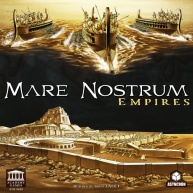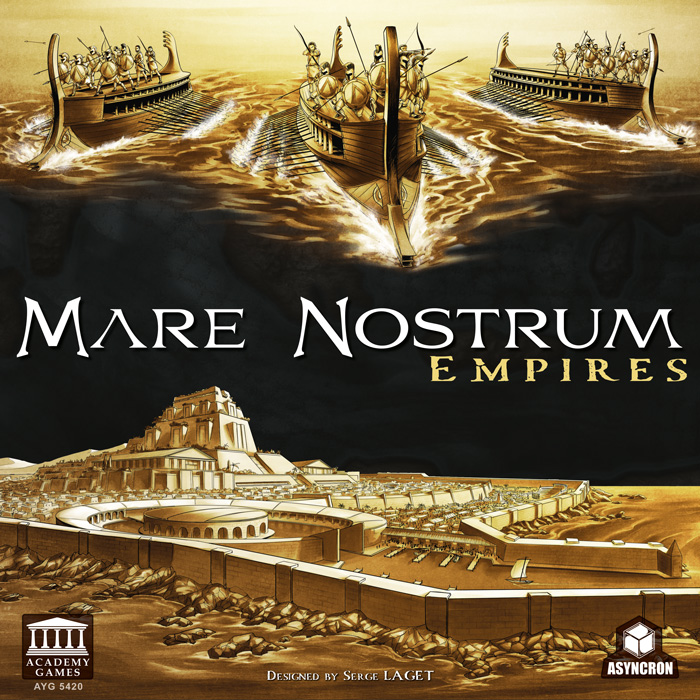 In this week’s “First Time Playing…” post, I’m going to give you another perspective on our gaming group’s first go with Mare Nostrum: Empires, a successful Kickstarter project launched in May of 2015 and funded 45 minutes later. Mare Nostrum went on to crush its funding goals with almost 7,000 backers pitching in nearly $680,000. Check out Alexander’s post here for a few more thoughts.
In this week’s “First Time Playing…” post, I’m going to give you another perspective on our gaming group’s first go with Mare Nostrum: Empires, a successful Kickstarter project launched in May of 2015 and funded 45 minutes later. Mare Nostrum went on to crush its funding goals with almost 7,000 backers pitching in nearly $680,000. Check out Alexander’s post here for a few more thoughts.
It’s important to note that Mare Nostrum: Empires is a re-implementation of the 2003 game called simply Mare Nostrum. And I’ve never played that one. The new version is published by Academy Games and designed by Serge Laget, who also designed the original.
Spoiler Alert I: I’m a fan of Kemet and Cyclades and you can feel echoes of those games in this one.
Spoiler Alert II: Historical themes, with even a modest attempt at realism, are also a big plus for me.
Now, let’s get to our First Time Playing… Mare Nostrum.
Mare Nostrum – which is Latin for “Our Sea” a Roman name for the Mediterranean Sea – pits 5 burgeoning empires against each other in a vicious friendly campaign for supremacy. This is an area control and resource collection game with a strong mix of battle and trading. As mentioned, historical motifs always make things interesting for me and here the 5 historical empires are:
- Rome, ably led by the warmonger Julius Caesar
- Carthage, more ably led by noted pachyophile* Hannibal
- Egypt, creatively led by oft-time Roman ally Cleopatra
- Greece, intelligently led by renowned statesman and orator Pericles. (Or, “Pairickles” if you prefer.)
- Babylon, not led in this game because it was only 4 players, but would have been led by the reputable (and long since dead) lawmaker Hammurabi.
Now, in one of my spoiler alerts I said that I appreciate it when historical games make an attempt at realism. In Mare Nostrum, locations and corresponding leaders are relatively on point – which I’m sure was the intent – but these leaders and empires did not share the same era. Hammurabi wins the prize (BY FAR) for “Most Anachronistic” having died more than 1,600 years before Caesar was born. (This feels egregious and solely for the sake of having a “celebrity” as the leader.) Pericles was dead 300 years before Caesar showed up and Hannibal was dead 80 years prior – so close. At least the young Cleopatra was contemporary with Caesar, so that counts for something. But still, fun to play with these empires and leaders.

How does one win when playing a game of Mare Nostrum? Well, let me count the ways:
- Build the Pyramids
- Build 5 Heroes and/or Wonders
- Control 4 Capital or Legendary Cities
- Lead all 3 leadership tracks
Ready? Let’s play!
Each round is played in 5 phases, play continues until at least one player meets one victory condition.
In the first phase, players collect their resources and predictably this phase is fast. The resources collected are dependent upon the cities a player controls for coins and caravans a player controls for commodities. Both can be difficult to come by, but especially commodities because they must be in the right combinations. You can pay in gold or in kind but you cannot use a combination. And when you pay in kind, every resource must be unique. Hannibal can pay with one duplicate resource which would come into play in this game.
The second phase is trading resources. In our first couple of rounds, the group felt that this was superfluous, extraneous and perhaps unnecessary. We were taught otherwise as play continued since this phase was critical to the final victory in this game. The trade leader selects how many commodities each player MUST trade in the phase and then each player places that number of commodities in front of their player screen. (Player screens are provided to hide the number

of resources a player has.) One at a time, players select a commodity from another player which leaves you with a different mix of commodities than possible by just collecting them from your own supply. Remember that in order to build a player must have a sufficient number of coins OR a sufficient number of unique commodities.
The third phase is for building. You can build a control marker to lay claim to an area and you can only build other structures in areas you control. From there, you can build caravans and markets to increase your commodity collection, legions, triremes** and fortresses to improve your military chances, or cities and temples to increase your control and coin collection. You can also use your build turn to build a hero or a wonder. Heroes and wonders can provide special abilities as well. Choose these wisely and align them with your victory strategy.
In the fourth phase, players can march and fight. (There are sea battles but these were nearly inconsequential in our game and perhaps an area for future

exploration.) With land battles, if you march your legion into an area where a competitor already has a military presence, there MUST be a battle. Battles are simple to resolve and, yes, dice are involved. (I also tend to prefer games that remove as much randomness as possible. I’m OK with lighter games having some randomness, but if I’m investing time and energy into a strategy I prefer to control my own destiny.)
Finally, in the fifth phase, you adjust the leadership track based on control of trade resources, military advantage and cities. If one player leads ALL THREE tracks at the end of this phase, they win. We almost had a surprise victory with that gambit. When the leadership track is altered the players who go first in each phase change based on that leadership. Control of the phases is also an essential dynamic of the game.
This first time playing series is intended to give you a feel for the game and help make a judgment of whether you should add the game to your collection. We know that everyone has different preferences and providing you with an overview like this can help make those decisions. Again, I haven’t covered all of the rules but enough to give you a sense of the game.

So what are my conclusions after one play? You can tell from my spoilers that it’s a thumbs up for me. Kemet and Cyclades are both great, entertaining games and I felt similarly about Mare Nostrum. One of the appealing aspects of these games is the multiple paths to victory.
We all love games where it’s only victory points that matter and certainly many games allow points to be collected in a variety of ways. However, with discrete and unique victory conditions, you can shift strategies to one that feels more attainable (as happened in our game) or keep your approach as hidden as possible to go for the surprise victory. Just fun.
In addition, in our play there was a serious ebb and flow as 3 different players came within a hair of victory. One player had all of the resources ready to buy the pyramids for an immediate victory before realizing that 1 of the commodities was a duplicate. Admittedly, I’m also a bit biased here. I focused almost exclusively on trade and resources with Hannibal and was able to build all of my heroes and wonders to take the win. In my very first build phase I had purchased Perseus, one of the Heroes. Perseus allows the owner to go first in the build phase if you are building you’re fifth hero/wonder and the game ends instantly. And that’s what happened in our first time playing Mare Nostrum: Empires.
My instant reaction:
I want to play again… right now!
I want to play again next week.
It’s a keeper, but I might not play for a month or so.
Let’s trade this one away!
*As far as I know, I made this word up. But it makes sense right? Also, to my great disappointment, not a single pachyderm was present in the game.
** Another anachronism, except for Mr. Pairickles.
-Matt
